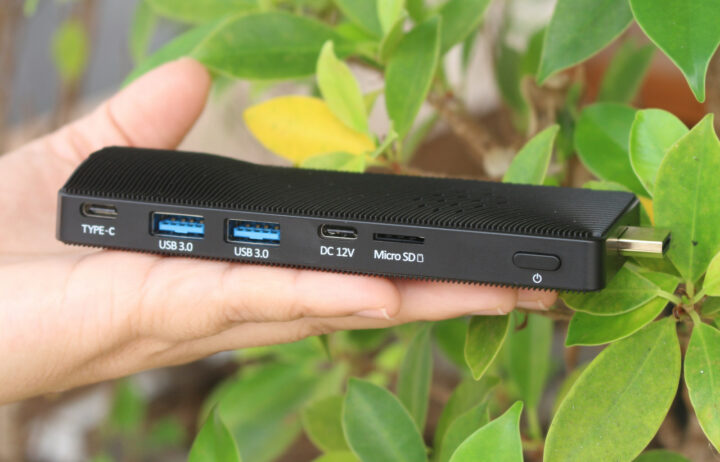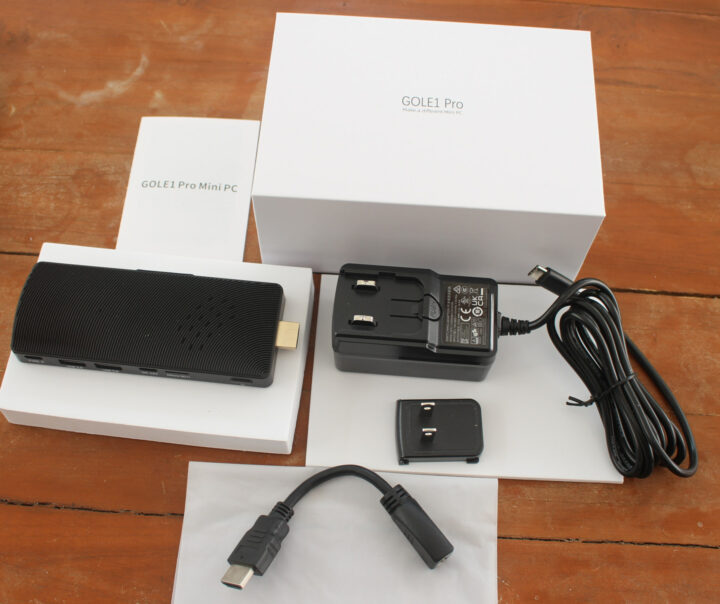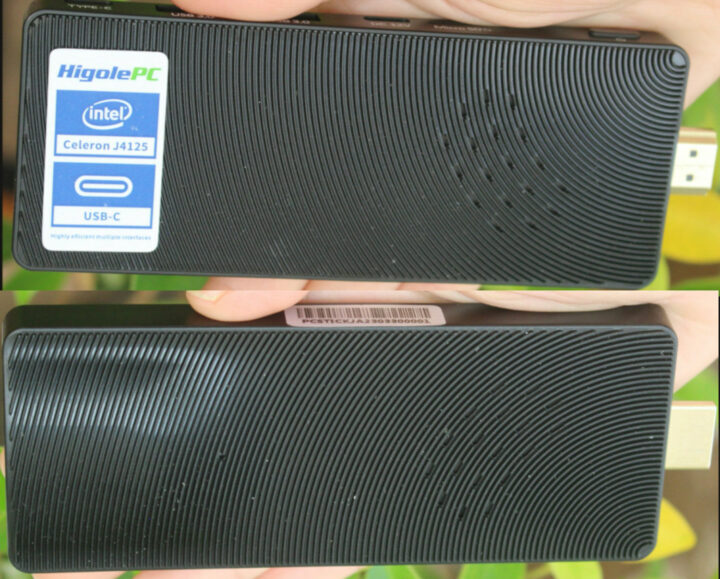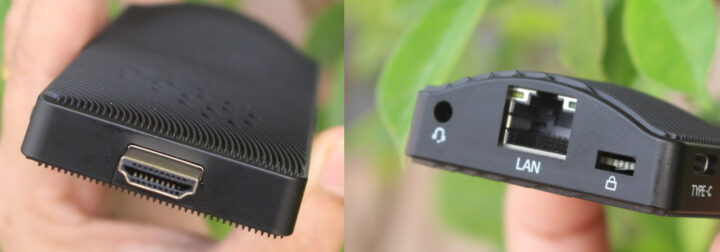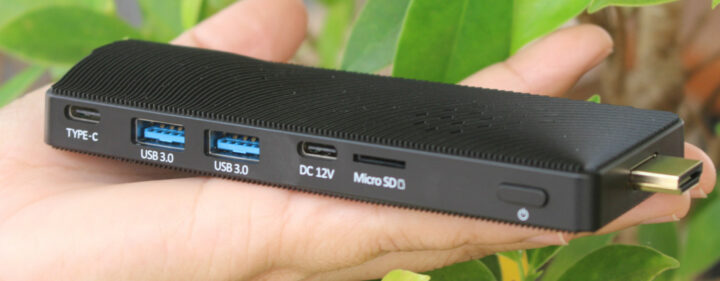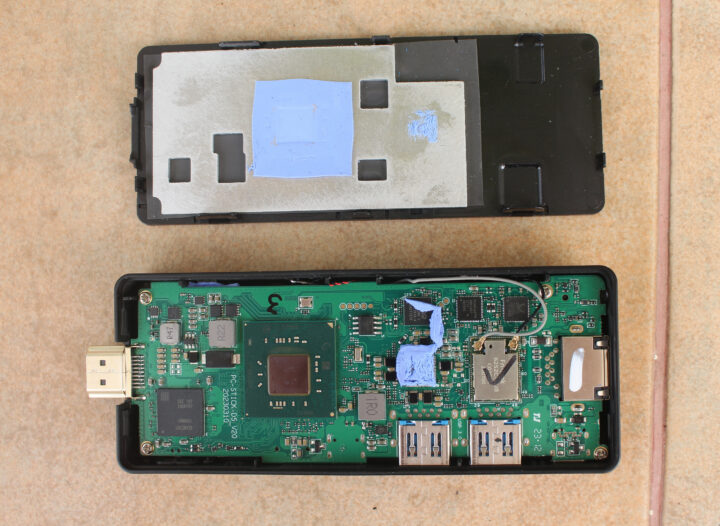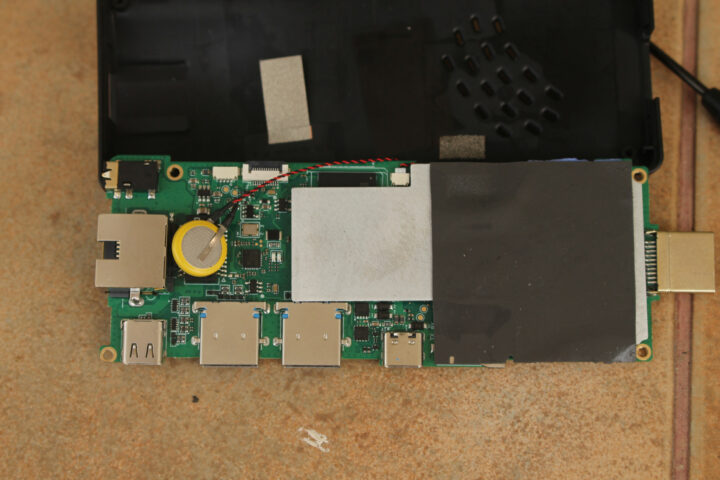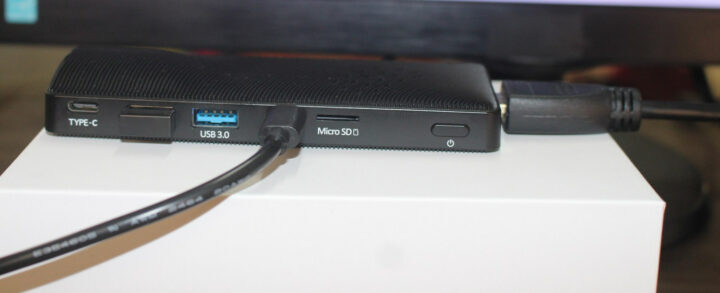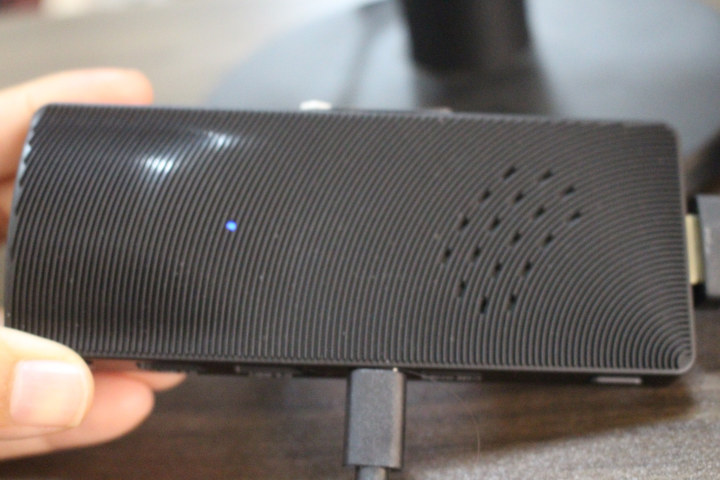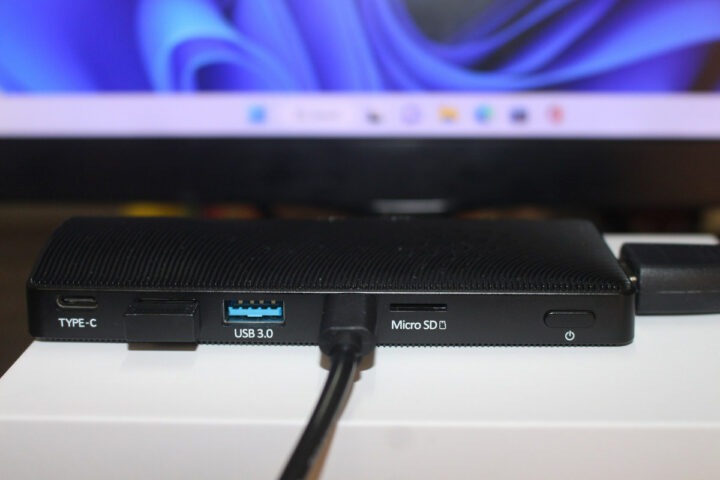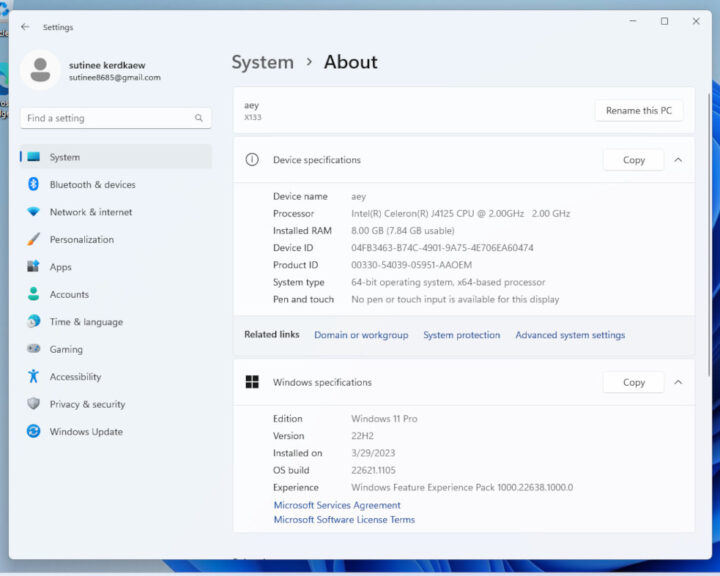HIGOLE PC STICK is a mini PC that looks like a large flash drive, is smaller than a regular mini PC, and is easier to carry around. You can connect it directly to a monitor or TV with an HDMI input, and use it like any computer right away. In part 1 of the HIGOLE PC STICK review, we will go through the specifications, unbox the design, check its hardware design with a teardown, and go through the first boot.
HIGOLE PC STICK specifications
The HIGOLE PC STICK is powered by an Intel Celeron J4125 quad-core Gemini Lake Refresh processor with 8GB RAM, 128GB flash, and microSD card slot for storage expansion. The mini PC comes with a Gigabit Ethernet port, WiFi 6 & Bluetooth 5.2 connectivity, and supports two independent displays through the HDMI 2.0 port and USB Type-C port. The device also includes two USB 3.0 ports, one other USB Type-C port for 12V DC input only, a headphone/mic audio jack, a Kensington lock slot, and a power button,
HIGOLE PC STICK specifications:
- SoC – Intel Celeron J4125 quad-core processor @2.7 GHz with 4MB cache; 14 nm manufacturing process
- System Memory – 8GB DDR4
- Storage – 128GB eMMC flash. microSD card slot
- Video Output
- HDMI 2.0 port up to 4Kp60
- DisplayPort via USB-C port up to 4Kp60
- Audio – 3.5mm audio jack for headphones and microphone, digital audio via HDMI and DisplayPort
- Networking
- Gigabit Ethernet RJ45 port
- WiFi 6 (802.11ax) and Bluetooth 5.2
- USB – 2x USB 3.0 ports, 2x USB Type-C port (1x for power only, 1x for data and video)
- Misc – Kensington Security Lock
- Power Supply – 12V/3A via USB Type-C port
- Dimenions – About 14 x 5 x 1 cm.
- Weight – 200 grams
- Material – Plastic
The HIGOLE PC STICK ships with Windows 11 Pro. The company says the PC stick is designed using eco-friendly materials) and save energy as well, claiming it is ideal for presentations, video streaming entertainment, digital signage, video conferencing, and games, it is now available on the Indiegogo crowdfunding site for $149 and up.
HIGOLE PC STICK unboxing
We were a little confused the first time we received the product, as the package reads GOLE1 Pro mini PC. But once we have a look inside, we can see the HIGOLE PC STICK (J4125), a short HDMI to HDMI cable, a 12V power adapter with a standard US plug, and a user manual that reads “GOLE1 Pro mini PC”.
The top and bottom sides of the PC STICK look like fins from a metal case, but they are actually made of eco-friendly plastic and we’ll notice some ventilation holes as well.
One of the edges of the stick comes with the HDMI 2.0 male port with up to 4Kp60 resolution, and the other edge features a Gigabit Ethernet RJ45 (LAN) port, the 3.5mm headphone and microphone jack, and a Kensington security lock slot.
All the USB ports are on one side of the mini PC with the 2-in-1 USB Type-C port, two USB 3.0 ports, the 12V DC port, a microSD card slot, and a power button.
Teardown
The PC stick can relatively easily be opened with a plastic tool by popping out the bottom cover.
The PC stick has a fanless design with a metal plate with thermal pads for the Intel processor and another chip. We’ll find a CHENGYAN K3UH7H 8GB LPDDR4 memory chip on the left, the J4125 processor in the middle, and a few more chips and modules on the right side of the board namely a Realtek ALC269 audio codec, a Slimport ANX7447 USB Type-C switch with DisplayPort Alt. mode support, an ENE KB9028G embedded controller, and an Fn-Link 6252C-UUB wireless module for WiFi 6 and Bluetooth 5.2 connectivity.
If we loosen four more screws, we can further take about the board, and we’ll see one more metal plate for cooling, internal antennas for WiFi and Bluetooth, and a CMOS battery.
Windows 11 Pro first boot
For the first boot, we connected the PC STICK’s HDMI port to a VGA computer monitor via an adapter. We also had to find an additional female-to-female adapter between the HDMI port and the provided HDMI cable. We also connected an RF dongle for the keyboard and mouse, and finally the 12V power adapter.
At this stage, you should see a red LED on the top of the device. If we press the power button on the right for a few seconds (we had to try several times), the LED will turn blue confirming the boot is in progress.
At this point, we’ll go through the usual Windows 11 Pro setup wizard to select language, Ethernet or WiFi networking, etc… We had some issues connecting to WiFi the first time as it was off for some unknown reason, and would not turn on. But eventually, it worked out fine, and we could access the Windows 11 Pro desktop with Internet connectivity.
Going to the System->About window confirms we’ve got a HIGOLE PC STICK with an Intel Celeron J4125 processor clocked at 2.0 GHz and 8 GB RAM, running Windows 11 Pro 64-bit.
We’d like to thank HIGOLE for sending me the PC STICK for review. In part 2 of the review, we will test its performance and features with Windows 11, before testing Ubuntu 22.04 on the device. The HIGOLE PC STICK is currently offered on Indiegogo with a $20,000 HKD ($2,548 US) flexible goal with a little over $5,000 US raised so far and 18 days to go. The PC Stick (J4125+WiFi 6.0) model reviewed here requires a $149 pledge, but there are also cheaper models with the PC Stick (J4125+WIFI 5.0) going for $129 US, and the PC Stick (N4100+WiFi 5.0) for $98. Prices include international shipping, and perks will be shipped soon after the crowdfunding campaign ends, or more exactly in May 2023.
The review is a translation, with some additional insights, of the original review published on CNX Software Thailand by Suthinee Kerdkaew.

Jean-Luc started CNX Software in 2010 as a part-time endeavor, before quitting his job as a software engineering manager, and starting to write daily news, and reviews full time later in 2011.
Support CNX Software! Donate via cryptocurrencies, become a Patron on Patreon, or purchase goods on Amazon or Aliexpress


